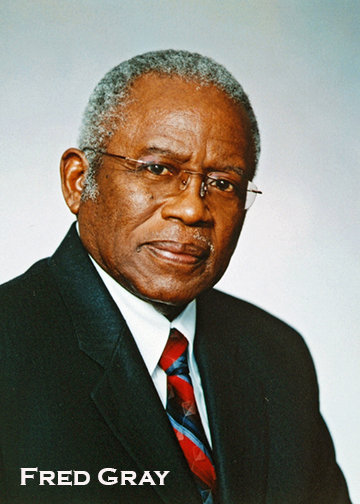
Civil rights attorney, author and former elected official Fred D. Gray spoke to a group of more than 300 trial attorneys attending the Jere F. White Jr. Trial Advocacy Institute Nov. 11 in Birmingham. Gray’s many clients have included the Selma Marchers, Martin Luther King Jr. and Rosa Parks, and he played a pivotal role in dismantling legal segregation in the state of Alabama.
Gray spoke about his decision to become an attorney, his involvement in the 1955 Montgomery bus boycott that launched his legal career and the mentors who helped him along the way.
According to Gray, his mother wanted him to become a preacher or a teacher. Early on, Gray decided that he would become a preacher, and started baptizing dogs, cats and any other animals he could find. After attending a religious boarding school in Nashville for high school and returning to Montgomery to attend college, he became increasingly unsettled by segregation and the humiliation it was causing African Americans, particularly related to the bus system on which he relied for public transportation.
“Because of the bus situation and recognizing the injustices that accompanied segregation, I made a personal, secret commitment that I was going to finish college, go to law school, finish law school, take the Alabama Bar Exam, become a lawyer and destroy segregation entirely,” explained Gray.
After graduating from Alabama State University and then Case Western Reserve University Law School in Cleveland, Ohio, Gray returned to Montgomery and set out as a solo practitioner. He soon met and was mentored by political activist Jo Anne Robinson and head of the local NAACP chapter E.D. Nixon.
When 15-year-old Claudette Colvin was arrested for refusing to give up her bus seat in March 1955, Gray was called to defend the teenager. Gray represented Colvin in a trial that lasted less than 20 minutes, and as expected, Colvin was found guilty of violating the segregation law and fined. At that point, Gray, Robinson and Nixon decided the bus system had to change, and that they would be prepared to do more than just dispose of the criminal aspect of it at the next opportunity.
On Dec. 1, 1955, Rosa Parks was arrested for failing to give up her seat and provided the opportunity the trio had hoped for. Gray represented Parks, who, like Colvin, was easily convicted of violating the segregation law and fined. This time, Gray appealed the ruling.
Robinson led a successful effort to get the black community to stay off the buses the day of Parks’ trial, and the movement grew from there.
“For the first time, you had 40,000 people working together to solve a problem,” said Gray. “Since we had asked people to stay off of the buses for one day during the trial, we needed to keep them off until they could return on a nonsegregated basis or until we got the issues resolved. Everyone understood what was at stake.”
African-American leaders created the Montgomery Improvement Association (MIA) to run the bus protest and elected Martin Luther King Jr. as president. King gave many powerful speeches during the bus boycott that energized and motivated participants, and catapulted him into the national spotlight, Gray said.
Gray eventually filed a law suit in federal court calling for an end to segregated buses. The bus boycott that began with Rosa Parks’ trial lasted 381 days and ended only when the United States Supreme Court agreed that the segregated bus system was unconstitutional in November 1956. It was the first of many civil rights cases that Gray would win in his career.
According to Gray, he would not have had the wisdom or courage to take on issues like bus segregation had it not been for mentors such as Robinson and Nixon, who encouraged and helped him along the way.
“I encourage all of you to mentor young people,” he said in closing. “Share your wisdom with them and help them, just as I was helped and many of you were helped. To the young people in the audience, don’t be afraid to ask for help. You may not know much yet, but with help, you can accomplish great things.”
The Jere F. White Jr. Trial Advocacy Institute, sponsored by Samford University’s Cumberland School of Law and the American College of Trial Lawyers, is the primary fundraising event for the law school’s prestigious Jere F. White Jr. Fellowship. This year’s event featured speakers from around the country who covered a variety of trial-related topics and strategies.
The Jere F. White Jr. Fellowship, which includes a full-tuition scholarship, an annual stipend, tuition and lodging at Cumberland School of Law’s Cambridge, England, Study Abroad Program, and various mentoring opportunities, is awarded to one entering student per year who demonstrates exceptional academic ability, a history of leadership and a considerable commitment to service. The fellowship was established by White and his wife, Lyda, prior to his death in October 2011.
A graduate of the University of Georgia and Cumberland School of Law, White was a founding member of Lightfoot, Franklin & White LLC in Birmingham.
“Jere will be long recognized as one of the most outstanding lawyers in the country,” Cumberland School of Law Dean Henry C. Strickland III said. “More importantly, he will be remembered as a great person, friend and mentor. We are honored to be able to continue his legacy through the Jere F. White Jr. Fellowship, which helps to promote the development of lawyers who share ideals that were so important to him.”
Polly Manuel is marketing and communication coordinator for Cumberland School of Law.
